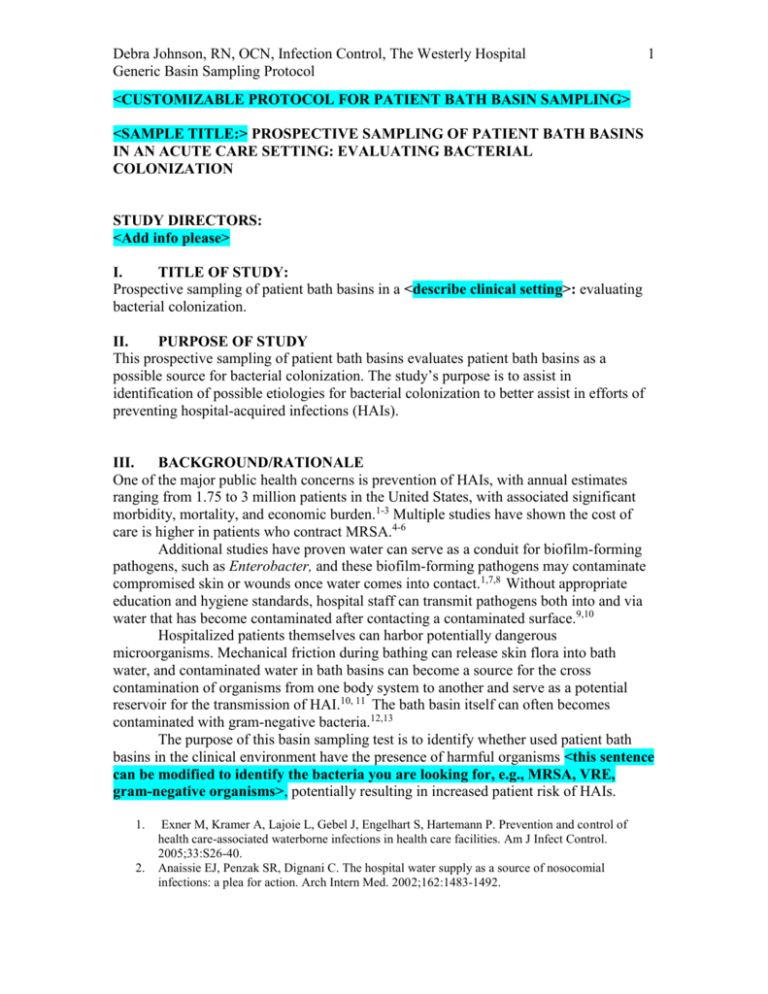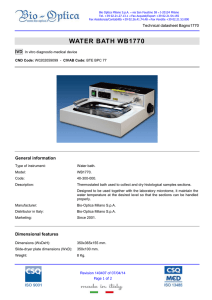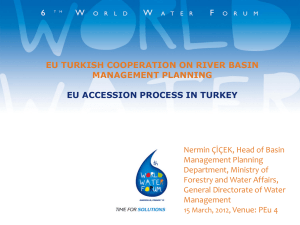20988 - Sage Products Inc.
advertisement

Debra Johnson, RN, OCN, Infection Control, The Westerly Hospital Generic Basin Sampling Protocol 1 <CUSTOMIZABLE PROTOCOL FOR PATIENT BATH BASIN SAMPLING> <SAMPLE TITLE:> PROSPECTIVE SAMPLING OF PATIENT BATH BASINS IN AN ACUTE CARE SETTING: EVALUATING BACTERIAL COLONIZATION STUDY DIRECTORS: <Add info please> I. TITLE OF STUDY: Prospective sampling of patient bath basins in a <describe clinical setting>: evaluating bacterial colonization. II. PURPOSE OF STUDY This prospective sampling of patient bath basins evaluates patient bath basins as a possible source for bacterial colonization. The study’s purpose is to assist in identification of possible etiologies for bacterial colonization to better assist in efforts of preventing hospital-acquired infections (HAIs). III. BACKGROUND/RATIONALE One of the major public health concerns is prevention of HAIs, with annual estimates ranging from 1.75 to 3 million patients in the United States, with associated significant morbidity, mortality, and economic burden.1-3 Multiple studies have shown the cost of care is higher in patients who contract MRSA.4-6 Additional studies have proven water can serve as a conduit for biofilm-forming pathogens, such as Enterobacter, and these biofilm-forming pathogens may contaminate compromised skin or wounds once water comes into contact.1,7,8 Without appropriate education and hygiene standards, hospital staff can transmit pathogens both into and via water that has become contaminated after contacting a contaminated surface.9,10 Hospitalized patients themselves can harbor potentially dangerous microorganisms. Mechanical friction during bathing can release skin flora into bath water, and contaminated water in bath basins can become a source for the cross contamination of organisms from one body system to another and serve as a potential reservoir for the transmission of HAI.10, 11 The bath basin itself can often becomes contaminated with gram-negative bacteria.12,13 The purpose of this basin sampling test is to identify whether used patient bath basins in the clinical environment have the presence of harmful organisms <this sentence can be modified to identify the bacteria you are looking for, e.g., MRSA, VRE, gram-negative organisms>, potentially resulting in increased patient risk of HAIs. 1. 2. Exner M, Kramer A, Lajoie L, Gebel J, Engelhart S, Hartemann P. Prevention and control of health care-associated waterborne infections in health care facilities. Am J Infect Control. 2005;33:S26-40. Anaissie EJ, Penzak SR, Dignani C. The hospital water supply as a source of nosocomial infections: a plea for action. Arch Intern Med. 2002;162:1483-1492. Debra Johnson, RN, OCN, Infection Control, The Westerly Hospital Generic Basin Sampling Protocol 3. 4. 5. 6. 2 Panhotra BR, Saxena AK, Al-Mulhim AS. Contamination of patients’ files in intensive care units: an indication for strict handwashing after entering case notes. Am J Infect Control. 2005;33:398401. Gavalda L, Masuet C, Beltran J, et al. Comparative cost of selective screening to prevent transmission of methicillin-resistant Staphylococcus aureus (MRSA), compared with the attributable costs of MRSA infection. Infect Control Hosp Epidemiol. 2006 Nov;27(11):1264-6. Epub 2006 Sep. Shorr AF, Tabak YP, Gupta V, Johannes RS, Liu LZ, Kollef MH. Morbidity and cost burden of methicillin-resistant Staphylococcus aureus in early onset ventilator-associated pneumonia. Crit Care. 2006;10(3):R97. Epub 2006 Jun 29. Nixon M, Jackson B, Varghese P, Jenkins D, Taylor G. Methicillin-resistant Staphylococcus aureus on orthopaedic wards: incidence, spread, mortality, cost and control. J Bone Joint Surg Br. 2006 Jun;88(6):812-7. 7. 8. 9. 10. 11. 12. 13. Clark AP, John LD. Nosocomial infections and bath water: any cause for concern? Clin Nurse Spec. 2006; 20:119-123. Leprat R, Demzot V, Bertrand X, Talon D. Non-touch fittings in hospitals: a possible source for Pseudomonas aeruginosa and Legionella spp. J Hosp Inf. 2003;53:77-82. Assadin O, El-Madini N, Seper E, et al. Sensor operated faucets: a possible source of nosocomial infection? Infect Control Hosp Epidemiol. 2002;23 44-46. Sehulster L, Chinn RYW. Guidelines for environmental infection control in health-care facilities: recommendations of CDC and the Healthcare Infection Control Practices Advisory Committee (HICPAC). MMWR Morb Mortal Wkly Rep . 2003;52:1-42. Sheffer P, Stout J, Wagener M, Muder R. Efficacy of new point of use water filter for preventing exposure to Legionella and waterborne bacteria. Am J Infect Control. 2005;33:S20-S25. Larson EL. Comparison of traditional and disposable bed baths in critically ill patients. Am J Crit Care. 2004;13:235-241. Skewes SM. No more bed baths! RN. 1994; 57(1):34-5. IV. RESEARCH PLAN 1. This study will evaluate patient bath basins as a possible etiology for bacterial colonization and increased risk for HAIs. 2. Patient caregivers will be blinded to the study. 3. Patients bath basins will be sampled provided the patient has been admitted >48 hours and bathed twice, as confirmed by patient record. 4. The bath basin will be sampled by an infectious disease specialist or registered nurse (RN) trained in the culturing techniques by culturing the entire interior perimeter and walls, as well as the base, <utilizing a culture sponge (see methods below): this sentence can be modified if you are using another type of swabbing tool>. 5. The infectious disease specialist or registered nurse trained in the culturing techniques will record the following data in spreadsheet format: <This data can be customized for study: Patient primary diagnosis and comorbidity; location of basin in patient’s room and unit designation; and contents (if any) within the basin>. 6. The infectious disease specialist or RN trained in the culturing techniques will label each patient’s basin culture and data collection form with a corresponding number for cross-checking results. V. STUDY OBJECTIVE Debra Johnson, RN, OCN, Infection Control, The Westerly Hospital Generic Basin Sampling Protocol 1) 2) 3 To determine whether or not the patient bath basin is a source for bacterial colonization and increased risk of HAI. To <can be customized based on your measures: quantitatively and qualitatively> culture patient bath basins to determine the type and amount of bacteria existent on bath basins, and a total of <customize for your study: 1 culture sponge> will be utilized per basin, with all surfaces of the walls and base of the basin cultured with the sponge. VI. STUDY DESIGN/METHODS This is a prospective, non-randomized, <enter “single or multiple institution”>, institution infectious disease study. <Consult with your laboratory and determine what you need to provide the laboratory & what the laboratory techniques for culturing include [sample text]: The infectious disease specialist or RN trained in culturing techniques will measure the dimensions of the basins and provide this information, along with the culture sponge. The cultures will be packaged and expressed mailed to the microbiological testing laboratory on the same day the samples were gathered. Once specimens are received in the laboratory, the sponge will be provided pre moistened with 10 ml of sterile diluent. The sponge will be aseptically removed from the package and the sample collected from the basin. The sponge will be returned to the package and sealed using the whirl-pak style tie. During testing an additional 90 ml of sterile diluent will be added to the sample to yield a 10 to 100 or 1:10 dilution. Aliquots will be plated on general and selective agars to yield countable plates at dilutions of 10-1, 10-2, and 10-3. The general agar plates will be completed using the pour plate technique and will yield a <10 CFU detection limit. The selective agar plates will be completed using the spread plate technique and will yield a <20 CFU detection limit. LAB will utilize a standard enrichment procedure to detect low level or stressed organisms present in the test fluid. After a 48 hour incubation period, aliquots will be streaked again onto the selective agars in an attempt to isolate and identify organisms from the sample. The results from the enrichment test will be qualitative only and reported as presence/absence per device.> Organism Identification & Confirmation: <Customize for the organisms you are trying to identify and confirm with your lab [sample text]: Select or target organisms such as S. aureus, P. aeruginosa, VRE, and C. albicans will be cultured using selective agars to aid in the detection process. All colonies recovered from these plates will need to be confirmed through standard techniques such as gram stains, bio-chemical tests, and/or API Identifications. Any confirmed coagulase Debra Johnson, RN, OCN, Infection Control, The Westerly Hospital Generic Basin Sampling Protocol 4 positive Staph colony will also further verified for a MRSA species by an agglutination test. All colonies isolated from the Total Aerobic Plate Count will be Gram stained. The gram negative colonies isolated can be used for the identification and detection of other gram negative bacilli in addition to E. coli not recovered on the specific selective agar plates chosen for the testing.> Reporting: <confirm that your lab will provide a report as follows> At the end of the study for each location, LAB will provide a summary report comparing the organism recovery. The report will include information detailing the types of organisms detected and potential health concerns. VII. STUDY POPULATION <This section can be customized to your patient population> Patient bath basins are to be sampled after patient has been admitted >48 hours and the basin utilized for whole body bathing at least twice; this is to be confirmed through patient records. VIII. EFFICACY ASSESSMENTS Efficacy will be evaluated by observing <can be customized to either qualitative or quantitative or both> qualitative and quantitative microbiological culture results. IX. SAFETY ASSESSMENTS Not applicable. X. BIOSTATISTICAL METHODS <Customize for the biostatistical analysis being conducted in this study> Alpha levels will be calculated separately from qualitative and quantitative culture reports. XI. MONITORING TECHNIQUES: A. Informed consent <customize: is not> necessary for this study. B. One infectious disease specialist or RN trained in the culturing techniques from each hospital will be assigned to carry out study activities, and patient caregivers will be blinded to the study. XII. SIGNIFICANCE OF THE STUDY IN RELATION TO HUMAN HEALTH BENEFITS This study will demonstrate there may be a significantly increased patient risk of HAIs due to patient bath basins being sites for bacterial colonization. XIII. POTENTIAL RISKS Not applicable. XIV PREVIOUS STUDIES Not applicable. Debra Johnson, RN, OCN, Infection Control, The Westerly Hospital Generic Basin Sampling Protocol XV. INFORMED CONSENT Not applicable. XVI. ESTIMATED PERIOD OF TIME TO COMPLETE STUDY 1. Time for basin sampling and data collection is <customize: 1 day>. 2. The estimated length of the study is [customize: <30 days]. 3. Number of sampled bath basins sought is a minimum of <customize: 15 basins, maximum of 30 basins>. 5





